Female artists celebrate womanhood through powerful self-portraits, body-positive imagery, and maternal journey depictions. They weave stories using mixed media collages, nature symbolism, and textile art that honors cultural heritage. Performance art transforms the female body into both canvas and statement, while digital platforms amplify feminist voices worldwide. Collaborative projects like murals and workshops create community spaces where diverse feminine experiences shine. These creative approaches reveal how art becomes a revolutionary tool for reclaiming female narratives and challenging outdated perceptions.
Key Takeaways
- Self-portraiture allows female artists to reclaim their authentic stories and challenge traditional beauty standards.
- Mixed media collages using fabrics, photographs, and personal artifacts illuminate forgotten female histories and experiences.
- Nature-inspired symbolism connects feminine forms to flowers, water, and earth, creating powerful visual metaphors.
- Body-positive art celebrates post-childbirth bodies, diverse figures, and uniqueness through vibrant colors and bold compositions.
- Artistic depictions of motherhood and domestic life transform ordinary moments into extraordinary statements about women’s experiences.
15 Female Art Ideas: Celebrating Feminine Forms & Expressions
Throughout history, female artists have boldly redefined how women are portrayed in art. Artists like Seema Kohli and Visithra Manikam celebrate diverse feminine forms, challenging traditional representations and promoting body positivity through their colorful works.
Feminist artists such as Georgia O’Keeffe and Frida Kahlo revolutionized art by focusing on the beauty and strength of women’s experiences. Their paintings didn’t just show the female body – they revealed its power!
Contemporary artists Jayasri Burman and Anjolie Ela Menon explore motherhood themes, portraying women as sources of mystical strength rather than passive subjects.
At events like the Bath Contemporary Artists’ Fair, artists Ruby McLaren and Maria Vasquez use vibrant colors to celebrate post-childbirth bodies, showing that beauty exists in all forms.
These artists prove that women’s bodies and experiences deserve to be celebrated, not hidden!
The Power of Self-Portraiture: Exploring Identity Through Female Gaze
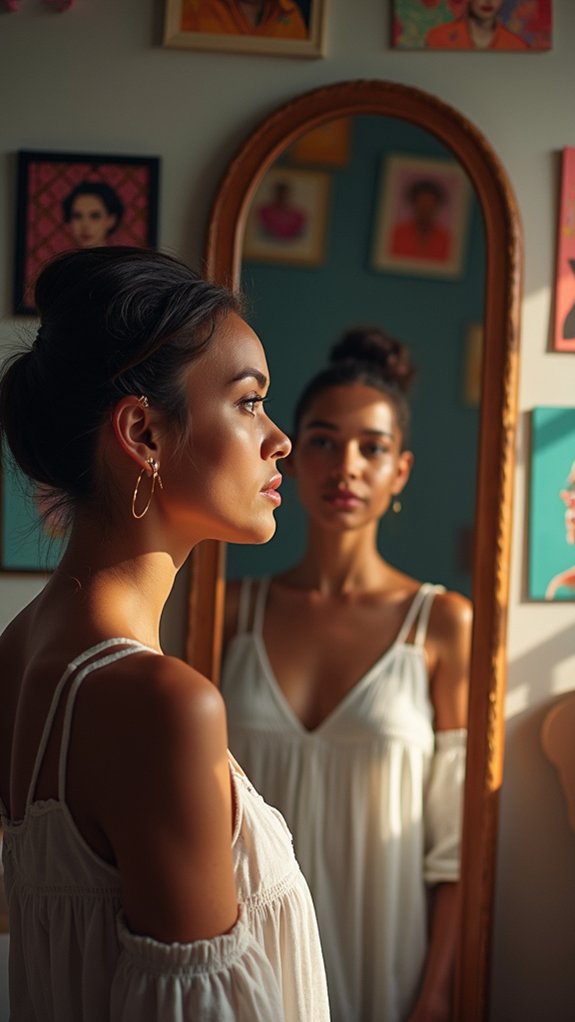
When female artists turn the camera or paintbrush toward themselves, they transform self-portraiture into a powerful act of reclaiming their own stories.
Artists like Maria Vasquez challenge old fairytales by casting themselves as both vulnerable and fierce Little Red Riding Hoods, showing how women contain many sides.
Self-portraiture allows female artists to celebrate their bodies through light and shadow, embracing every curve and line that society might label as “flaws.”
Many use their art to push back against impossible beauty standards, proudly displaying the changes that come with motherhood or aging.
These self-portraits create an honest conversation between artist and viewer, exploring what it means to be both powerful and vulnerable as a woman.
Through their own gaze, these artists capture the rich, complex tapestry of female identity.
Body-Positive Art: Embracing Diverse Female Forms
Every canvas and photograph in body-positive art creates an alternative vision of beauty that challenges what magazines and social media constantly tell women they should look like.
Artists like Visithra Manikam shine a spotlight on underrepresented female bodies, showing strength and confidence instead of the same old cookie-cutter images.
Ruby McLaren’s work celebrates post-baby bodies, helping new moms feel proud of the amazing changes their bodies go through.
Meanwhile, Maria Vasquez uses self-portraits to show off natural features and so-called “imperfections” that are actually part of what makes each woman unique.
Even CK Fitzgerald’s costume designs play with traditional ideas about how the female body should be dressed, proving that women’s bodies are perfect in all their wonderful variety.
Maternal Journeys: Artistic Expressions of Motherhood
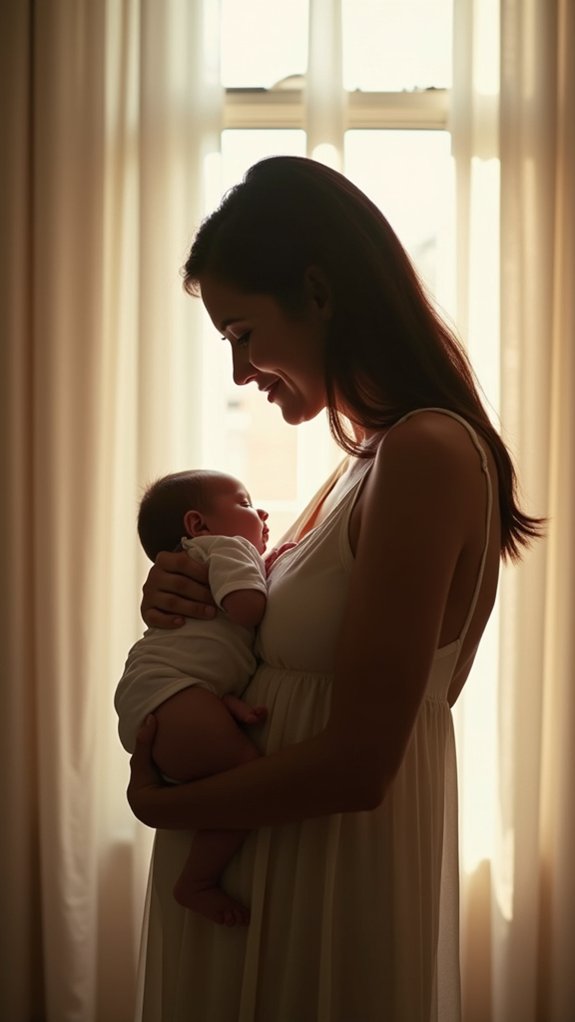
Motherhood transforms artists just as profoundly as it changes their bodies, inspiring breathtaking works that capture both the pain and wonder of bringing new life into the world. Artists like Ruby McLaren celebrate the post-birth female form, showing stretch marks and changed shapes as badges of honor, not flaws to fix.
| Artist | Artwork | Focus |
|---|---|---|
| Jayasri Burman | “Prasav or Utpatti” | Nurturing power |
| Anjolie Ela Menon | “Mother and Child” | Emotional bonds |
| Maria Vasquez | Self-portraits | Identity transformation |
Through their artistry, these women tell honest stories about motherhood that many keep hidden. Helena Almeida’s work becomes an extension of herself, blurring the line between art and artist, just as a mother’s identity merges with her child’s while remaining distinctly her own.
Mixed Media Collage: Layering Female Narratives
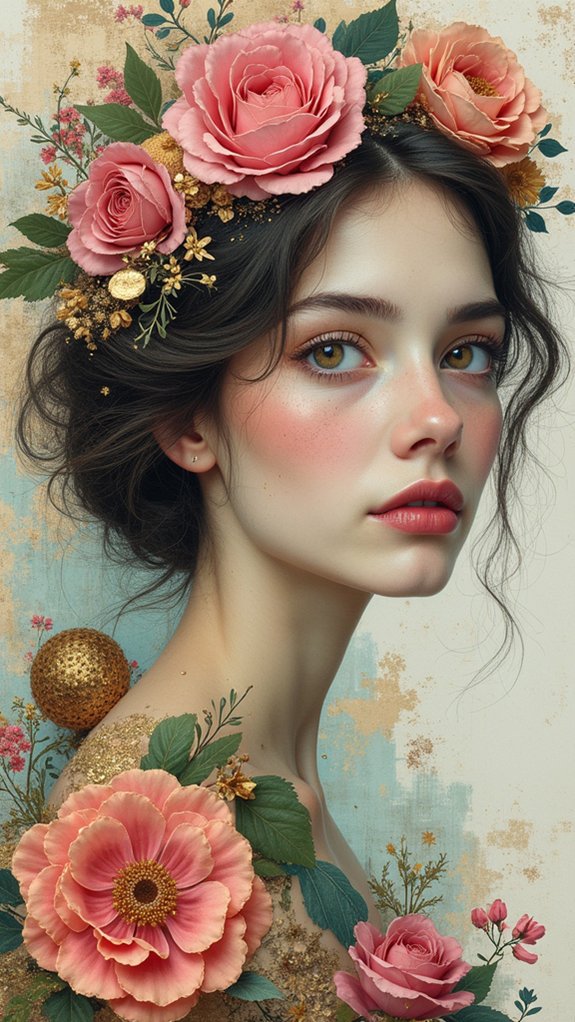
Mixed media collage allows women artists to reclaim and illuminate histories that have long been pushed aside, bringing forgotten female voices back into the spotlight through layers of photos, fabric, and found objects.
These textured creations build unique feminine identities piece by piece, much like women themselves construct their sense of self from various life experiences and cultural influences.
With their hands deep in glue and intuition as their guide, artists transform ordinary materials into extraordinary visual stories that celebrate the complex, beautiful mess of what it means to be female in the present day world.
Layering Forgotten Histories
Throughout history, women artists have been pushed into the shadows, their creative voices silenced and their contributions forgotten. Mixed media collage offers a powerful tool for reclaiming these narratives, as artists piece together forgotten stories through layered materials. This artistic approach breathes life into historical women whose achievements were erased, creating visual testimonies that demand attention.
- Using fabric scraps from traditional “women’s work” alongside historical photographs creates a conversation between past and present female experiences.
- Incorporating handwritten letters, diary entries, or newspaper clippings gives voice to women who weren’t allowed to speak publicly.
- Layering transparent materials symbolizes how women’s contributions have been visible yet overlooked, allowing viewers to peer through history’s veil.
The tactile nature of mixed media makes these forgotten histories tangible, turning abstract injustices into something we can literally touch.
Textured Feminine Identities
In the intricate world of mixed media collage, female artists weave together diverse materials that speak volumes about their lived experiences. By layering fabric, paper, paint, and found objects, they create textured feminine identities that capture the complexity of womanhood.
It’s like building a visual autobiography with scraps and colors!
Artists like Gogi Saroj Pal brilliantly mix mythological elements with modern-day challenges, showing that women’s stories aren’t one-dimensional. This approach serves as a powerful tool to express the many layers of feminine identity—celebrating diverse body types and challenging outdated stereotypes.
Through the tactile nature of collage, women reclaim their narratives from society’s narrow definitions. Each layer represents a different facet of experience, creating artwork that feels as complex and multidimensional as the women who create it.
Abstract Representations of Feminine Energy
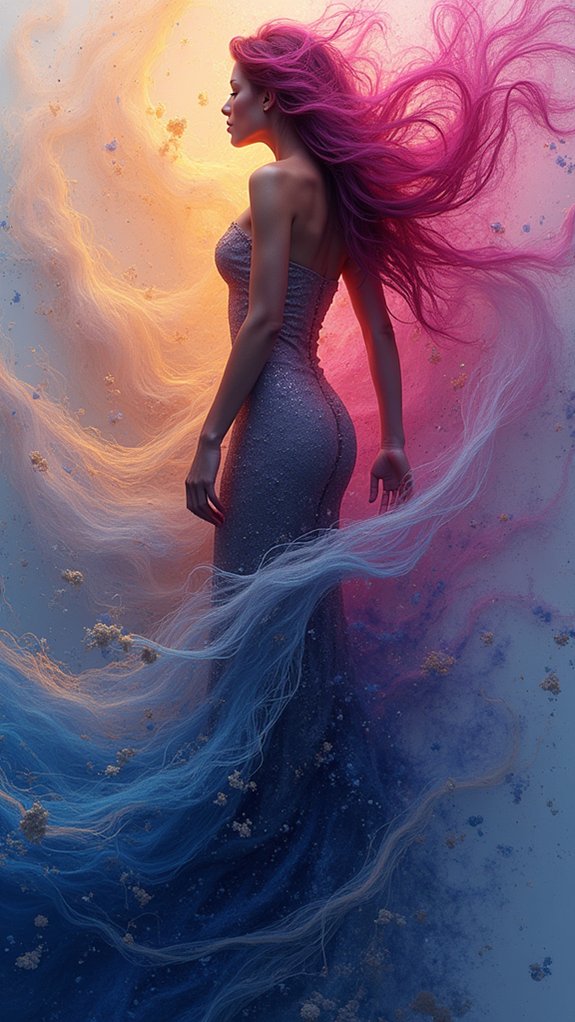
Abstract artists explore feminine energy by focusing on its spiritual essence rather than traditional physical forms.
They use flowing shapes, vibrant colors, and symbolic patterns to show how feminine power exists beyond the body, connecting to something deeper and more universal.
This approach lets artists like Seema Kohli and Ruby McLaren reveal the invisible aspects of womanhood—the energy, consciousness, and spiritual strength that can’t be captured in realistic portraits.
Spiritual Energy Visualizations
Vibrant colors and flowing shapes dance across the canvas when artists express the essence of feminine energy in spiritual visualizations.
These powerful works celebrate women’s spiritual energy through ethereal motifs and organic forms that capture the life-giving magic of femininity. Artists like Seema Kohli use symbols—inverted triangles and embryos—to show the amazing regenerative power that connects women to the universe.
These visualizations serve three important purposes:
- Empowering women to reclaim their spiritual identities
- Expressing the beautiful union between body and consciousness
- Creating visual languages that honor feminine creation and growth
The mystical artwork becomes a journey, not just for the artist but for viewers too, inviting everyone to explore the interconnectedness of all life through the lens of feminine spiritual power.
Beyond Physical Form
When artists move beyond the physical body to capture the essence of feminine energy, a whole new world of expression emerges. Artists like Seema Kohli connect body and consciousness, revealing spiritual dimensions of womanhood that transcend literal representation.
| Artist | Focus | Symbol | Emotion | Meaning |
|---|---|---|---|---|
| Kohli | Consciousness | Inverted Triangle | Spiritual | Regeneration |
| Chander | Torso | Body Parts | Sensual | Universality |
| Burman | Nurturing | Nature | Maternal | Life Source |
| Almeida | Body-Art Link | Transformation | Personal | Emotional Depth |
| Abstract | Energy | Motion | Powerful | Beyond Form |
This approach to feminine artistry invites viewers to feel rather than simply see. By using symbols and abstract forms, these artists tap into something magical—the invisible yet powerful feminine energy that flows through creation, motherhood, and spiritual awareness.
Cultural Heritage and Femininity in Contemporary Art
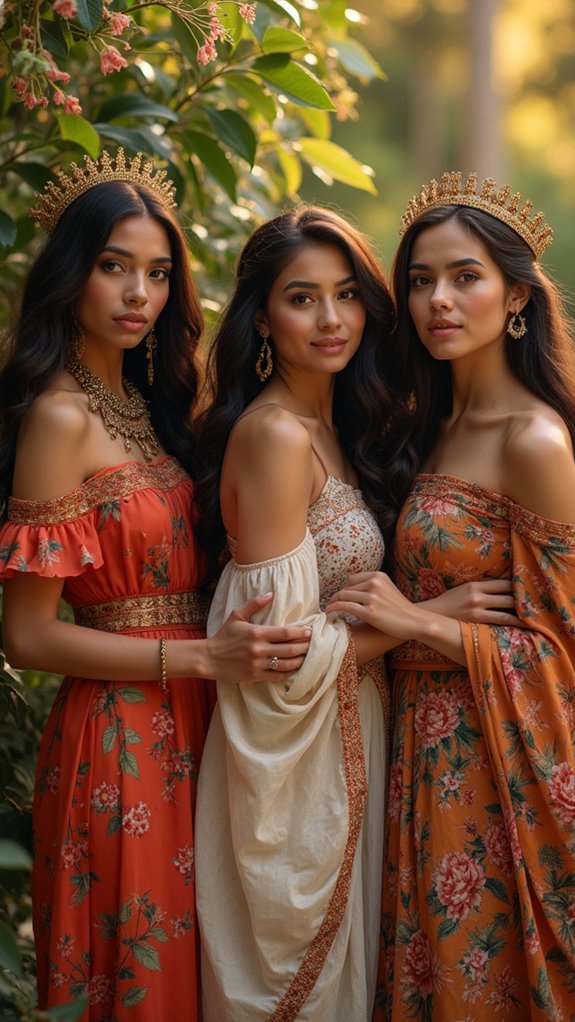
Female artists throughout history have woven their cultural heritage into stunning artworks that celebrate femininity in all its forms. Contemporary creators like Frida Kahlo and Anjolie Ela Menon draw from their roots to explore identity, motherhood, and resilience, creating vibrant pieces that speak across generations.
Mythology becomes a powerful tool in these expressions, allowing artists to connect ancient stories with modern challenges.
- Gogi Saroj Pal’s artwork highlights women’s struggles and triumphs through colorful cultural references that grab your attention.
- Seema Kohli transforms Goddesses into symbols of feminine power, mixing the spiritual with everyday experiences.
- Traditional motifs get exciting makeovers in these pieces, challenging how we think about women’s roles.
This artistic exploration creates bridges between past and present, sparking conversations about female empowerment within cultural contexts.
Textile Art: Weaving Women’s Stories Through Fabric
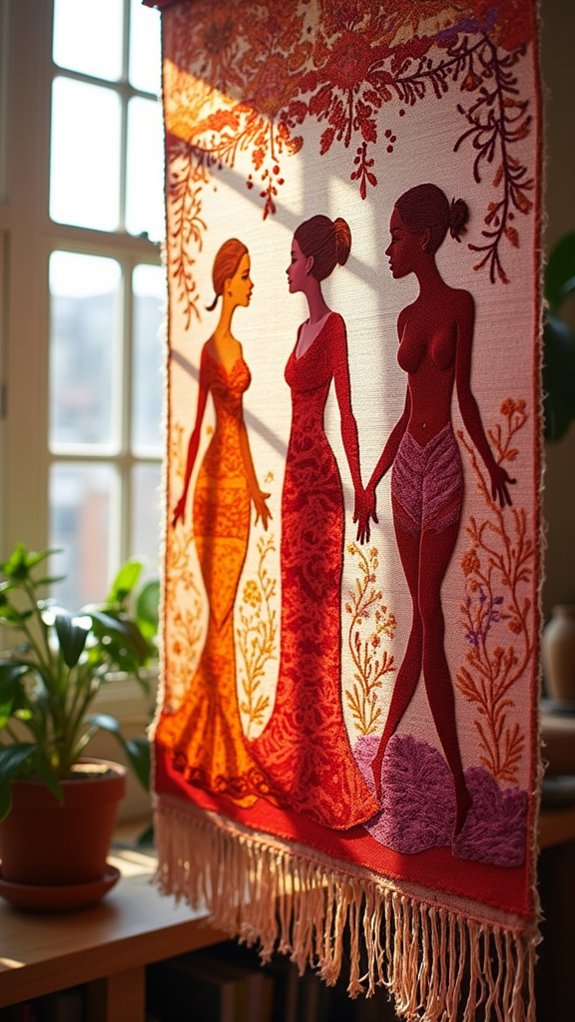
Threads of history and personal experience intertwine beautifully in textile art, where fabric becomes a canvas for women’s untold stories. From the vibrant textiles of West Bengal to intricate quilting traditions, women artists transform ordinary materials into extraordinary expressions of identity and resilience.
Like the stunning Indian artistry—inside Rooshad Shroff’s gallery, these works challenge expectations about “women’s crafts,” elevating them to fine art status.
Artists like Faith Ringgold use fabric to stitch together cultural narratives that might otherwise be forgotten, creating quilts that practically buzz with life and memory!
Through needle and thread, women reclaim their voices, weaving together communities and challenging body image norms. What was once dismissed as mere domestic work now stands tall in galleries worldwide, proving that sometimes the most powerful statements come wrapped in the softest materials.
Female Mythology: Reimagining Ancient Goddesses

Throughout history, ancient goddesses have inspired artists to reimagine female power in bold, exciting ways. Modern female artists are breathing new life into these divine figures, giving us a rare glimpse into how mythology can speak to today’s women.
These reinterpretations celebrate diverse body types and powerful feminine traits that go beyond traditional portrayals.
- Artists like Seema Kohli transform goddesses such as Kali into symbols of regeneration and creative energy.
- These divine feminine representations highlight the deep connection between womanhood, nature, and life’s cycles.
- By drawing from cultural heritage, these works spark conversations about women’s changing roles.
Celebrating women through mythological imagery offers a powerful counter-narrative to restrictive female stereotypes.
These artistic revivals explore the messy, beautiful complexities of femininity—from motherhood to sexuality to personal power—in ways that resonate with contemporary audiences.
The Beauty of Aging: Celebrating Women Across Generations
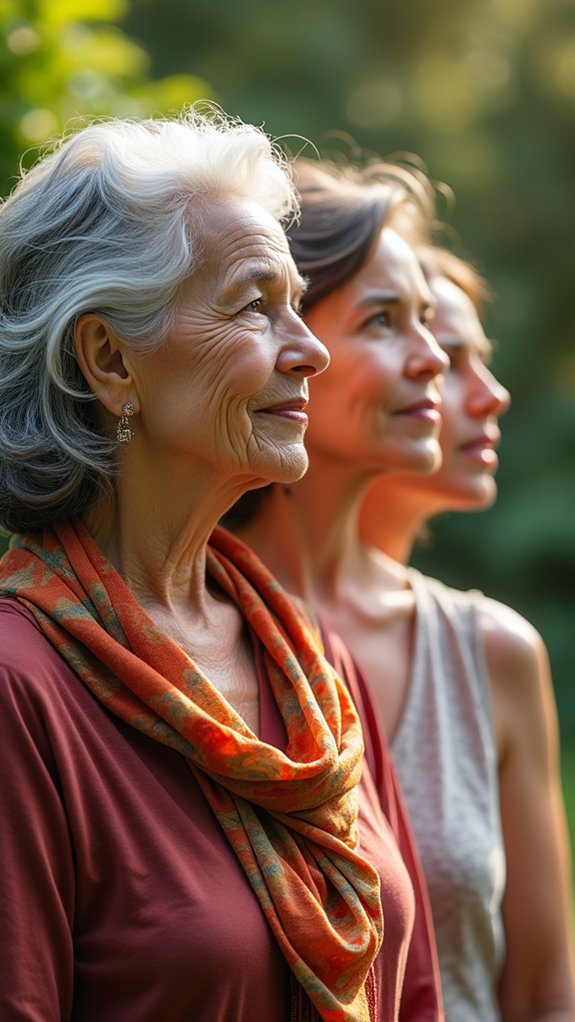
Artists who paint older women capture the “Wisdom in Wrinkles,” showing how each line tells a story of courage, love, and experience.
Through “Intergenerational Art Conversations,” creators spark meaningful discussions when they place grandmothers alongside their daughters and granddaughters, highlighting how beauty evolves rather than fades.
Moving “Beyond Youth Bias,” these powerful artworks challenge us to see that true beauty includes silver hair and knowing eyes, not just smooth skin and youth.
Wisdom in Wrinkles
In society’s gallery of feminine beauty, the exquisite artwork of aging faces is often overlooked. The wisdom in wrinkles represents chapters of life’s story, etched into expressions that have witnessed joy, sorrow, and everything in between.
Celebrating the beauty of aging means recognizing that each line carries profound meaning—memories of laughter, tears shed, and challenges overcome.
- Artists who capture older women often highlight the texture and character that only time can create, showing how beauty evolves rather than fades.
- The silver strands and soft creases become nature’s most honest poetry, telling stories no youthful face could possibly narrate.
- When painted or sculpted thoughtfully, an elder woman’s gaze reveals depths of experience that command respect, not pity.
Intergenerational Art Conversations
When generations of women gather to create art together, something magical happens. The beauty of aging comes alive on canvas, as grandmothers, mothers, and daughters exchange perspectives through their artistry.
These intergenerational conversations celebrate the female experience at every stage, from the vibrant energy of youth to the earned wisdom of later years.
Artists like Kanchan Chander show how themes of motherhood and sensuality evolve across a lifetime, while icons such as Frida Kahlo and Louise Bourgeois create works that speak to women of all ages.
Through shared creative spaces, women challenge outdated beauty standards and redefine femininity on their own terms.
These artistic dialogues aren’t just about making pretty pictures—they’re about honoring each wrinkle and story, building bridges between generations that might otherwise never connect.
Beyond Youth Bias
Society often whispers that beauty fades with age, but the canvas tells a different story.
Artists like Georgia O’Keeffe and Frida Kahlo have boldly captured the grace that comes with time, showing how beauty transcends age through their powerful self-portraits and celebrations of feminine wisdom.
Celebrating aging women in art does more than challenge outdated ideas—it creates new conversations about what beauty really means:
- It showcases the unique strength and character that only appears through living a full life.
- It helps younger generations see aging as a journey to look forward to, not fear.
- It gives older women the representation they deserve in galleries often flooded with youth.
These artworks remind us that women don’t fade—they ripen, gaining depth and dimension worth celebrating.
Intimate Spaces: Domestic Life Through a Feminist Lens
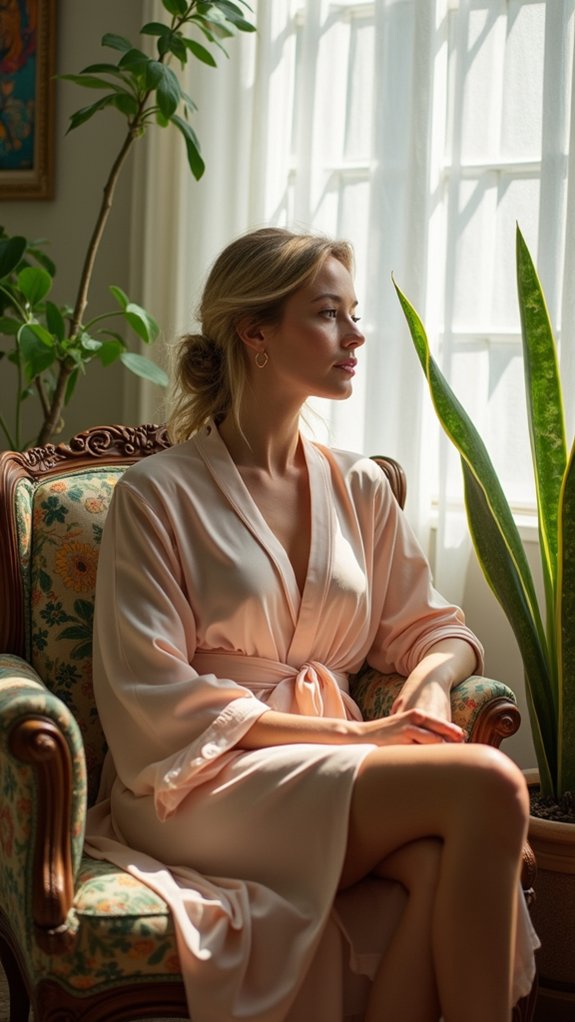
Domestic spaces have long served as battlegrounds where women’s voices emerge through artistic expression, challenging what society expects from them. Through colorful paintings, striking photographs, and bold installations, feminist artists transform kitchens, bedrooms, and living rooms into powerful statements about women’s lives and work.
When artists show a mother cradling her child or a woman cooking dinner, they’re saying, “Look at this work—it matters!” They pull back the curtain on domestic life, revealing the sweat, tears, and joy that happen behind closed doors. What once seemed ordinary becomes extraordinary through their eyes.
These intimate spaces tell stories that connect personal struggles with bigger social issues, turning private moments into shared experiences that make us question, laugh, and sometimes cry.
Nature-Inspired Symbolism in Female Art
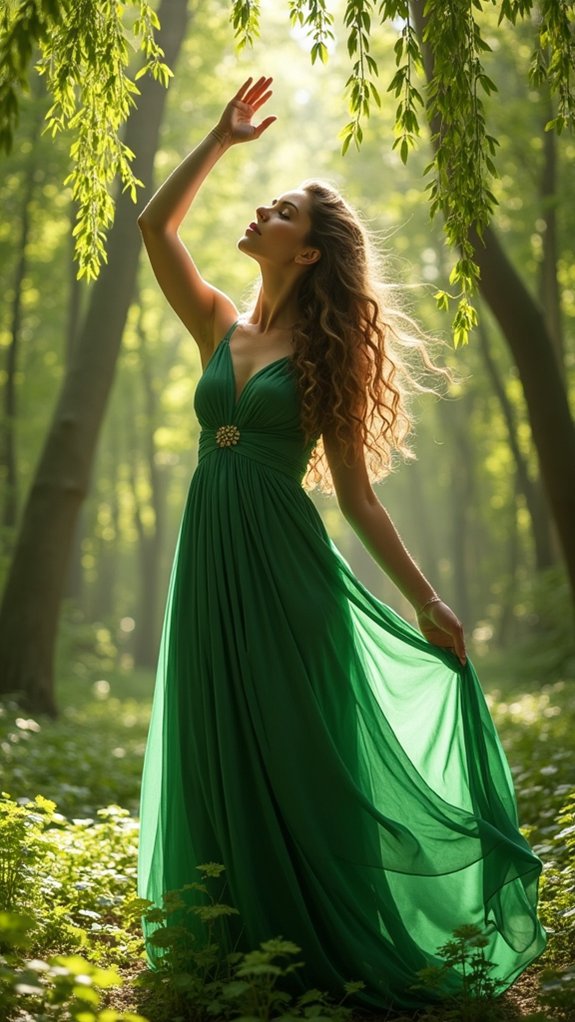
Female artists often express their connection to femininity through nature symbols found in their surroundings.
They transform flowers, water, and earth into powerful representations of women’s bodies, strength, and experiences.
Artists like Georgia O’Keeffe and Gogi Saroj Pal use these natural elements to challenge traditional views of women while celebrating the unique power of feminine creation and renewal.
Natural Feminine Symbolism
Throughout history, natural imagery has flowed through women’s art like a river carving its path through stone. Artists connect the female body with nature’s forms to express power and vulnerability simultaneously. The natural curves of flowers, the strength of trees, and the flowing movements of water mirror women’s experiences in stunning visual metaphors.
When exploring natural feminine symbolism, artists often:
- Use vibrant organic shapes that celebrate feminine forms without objectification
- Incorporate cyclical patterns like seasons and moon phases to represent women’s life journeys
- Layer natural textures that invite viewers to reconsider what “beauty” truly means
This symbolic language allows artists to challenge limiting perceptions while honoring women’s multidimensional existence.
Floral Body Representations
When flowers and female bodies intertwine in art, they create a powerful visual language that speaks to life’s most fundamental truths. Artists like Georgia O’Keeffe have masterfully used these floral body representations to celebrate the intricate beauty of womanhood, turning petals and stems into metaphors for feminine strength.
| Floral Element | Body Connection | Symbolic Meaning |
|---|---|---|
| Blooming flowers | Feminine curves | Growth and potential |
| Vibrant colors | Emotional depth | Passion and liveliness |
| Delicate petals | Skin textures | Sensitivity and resilience |
These nature-inspired images aren’t just pretty pictures—they’re powerful statements about celebrating femininity in all its forms! By comparing women to gardens, artists show how we all have the ability to grow, transform, and bloom despite challenges. Flowers in female art remind us that beauty comes with strength, just like a rose with its thorns.
Performance Art: The Female Body as Medium
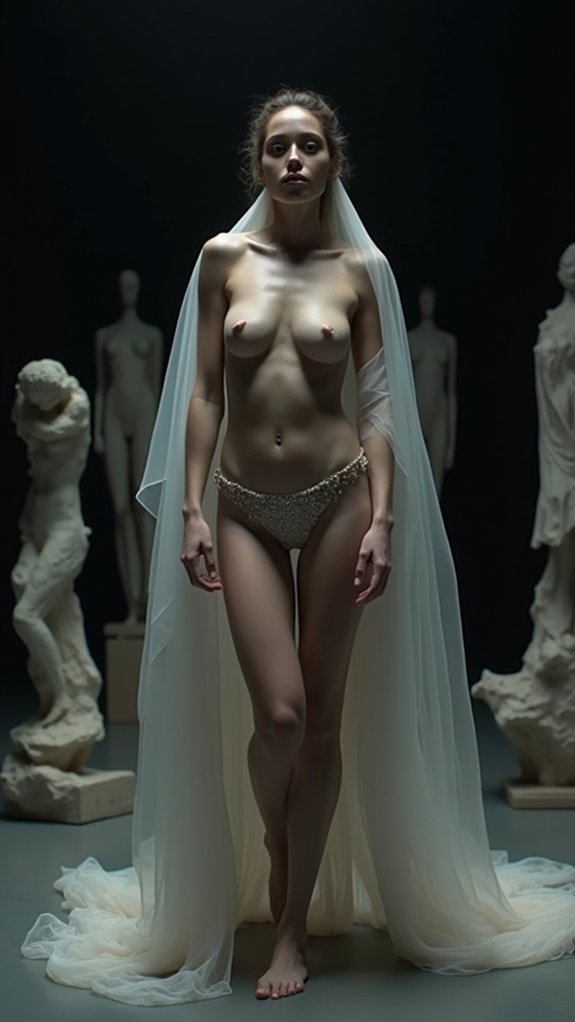
The powerful medium of performance art transforms a woman’s body into both canvas and statement, challenging how society views femininity. Artists like Marina Abramović and Yoko Ono use their physical presence to explore deep themes of strength, vulnerability, and endurance that words alone can’t express.
In performance art, a woman’s body becomes her revolution—speaking truths society often tries to silence.
When a female performer steps into various roles, she’s breaking free from society’s boxes and showing how complex womanhood really is.
- Female performers often create powerful connections with audiences, making everyone part of the art experience.
- Through their bodies, artists can highlight important women’s rights issues without saying a single word.
- Performance art celebrates all types of feminine expression, not just the ones we typically see in magazines.
Performance art doesn’t just display the female body—it gives it a voice.
Digital Art and Feminist Expression in the Modern Age
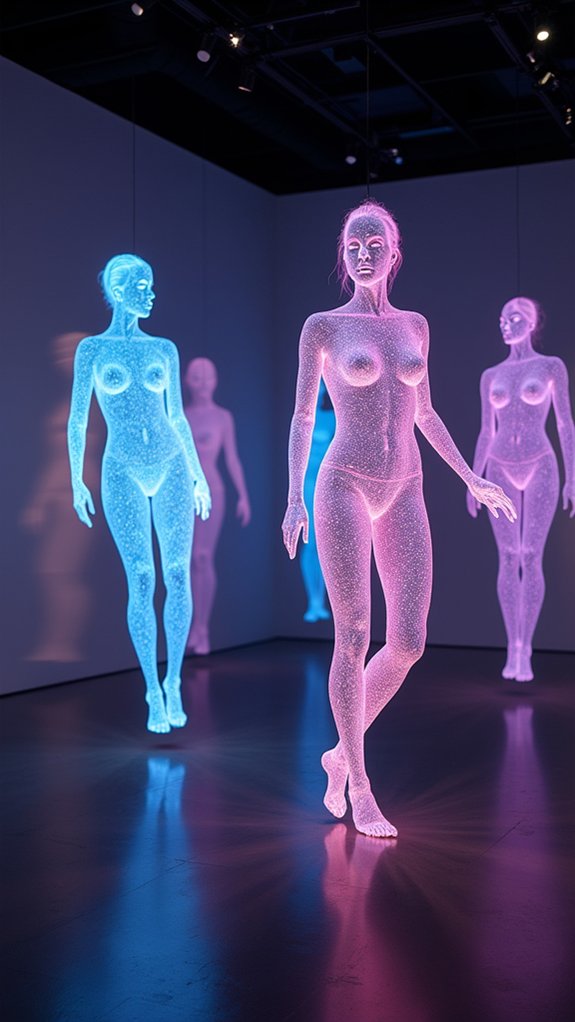
While performance art brings female bodies into physical spaces, digital technology has opened up entirely new worlds for feminist artists to explore. Through pixels and programs, women artists now craft powerful feminist expression that reaches global audiences instantly, bypassing traditional gatekeepers of the art world.
Digital art allows female creators to play with identity, challenging outdated ideas about femininity through animations, graphics, and interactive works. On social media platforms, these artists build supportive communities where their bold visions thrive. They cleverly use visual symbols to tackle issues like body image and gender equality.
What’s amazing is how digital tools let artists reshape reality itself! A woman can literally redraw the boundaries of her existence, creating worlds where female perspectives aren’t footnotes but the main story being told.
Collaborative Female Art Projects: Strength in Unity
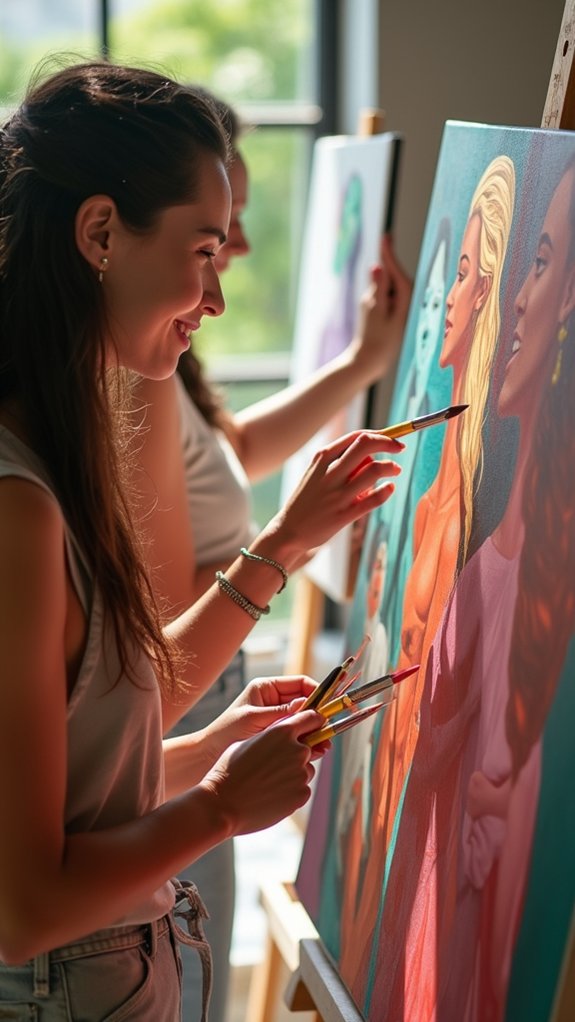
Solidarity emerges as a powerful force when female artists join hands to create collaborative masterpieces. When women unite their artistic talents, they build bridges of understanding while celebrating their diverse perspectives and experiences.
Projects like Judy Chicago’s “The Dinner Party” showcase how teamwork can transform individual voices into powerful artistic statements about femininity and history.
- Art collectives tackle gender inequality through eye-catching installations that make viewers stop, think, and question society’s rules.
- Public murals created by multiple female artists transform boring city walls into colorful celebrations of womanhood.
- Collaborative workshops bring together artists of different backgrounds to share techniques, stories, and create amazing mixed-media projects.
These joint ventures don’t just produce stunning artwork—they create supportive communities where women lift each other up, proving that together, their creative voices become impossible to ignore.
Frequently Asked Questions
How Do I Price My Feminine-Focused Artwork Appropriately?
Pricing requires clear strategies that reflect artistic skill level, market research, and production costs. Artists should develop value perception by consistently pricing across similar works and building reputation.
Can Male Artists Authentically Create Female-Centered Art?
Male artists can create authentic female-centered art through research, collaboration, and respectful representation. Artistic authenticity emerges from empathy rather than gender, though male perspectives inevitably influence creative interpretations of feminine experiences.
How Do I Handle Criticism of Intimate or Vulnerable Feminine Art?
Artists should employ self-reflection techniques when processing criticism of intimate works. Distinguishing between constructive feedback and subjective opinions helps maintain artistic integrity while still evolving one’s vulnerable creative expressions.
Where Can Emerging Female Artists Find Supportive Exhibition Opportunities?
Emerging artists can seek exhibition opportunities at community galleries, local arts centers, university spaces, and through art grants specifically designed for underrepresented voices in the contemporary visual arts scene.
How Has Social Media Affected the Reception of Feminist Art?
Social media has democratized feminist art’s reach, bypassing traditional gatekeepers. Platforms enable diverse feminist voices while simultaneously exposing work to heightened scrutiny and occasional backlash from broader audiences.
Conclusion
Female art continues to break barriers, challenge norms, and celebrate the diverse experiences of women. Through various mediums and expressions, artists capture the beauty, struggle, and triumph of femininity. As more young artists find their voice, the terrain of female art grows richer and more inclusive. By exploring these creative paths, anyone can contribute to this powerful tradition that honors women’s stories, bodies, and visions in all their wonderful complexity.


Leave a Reply